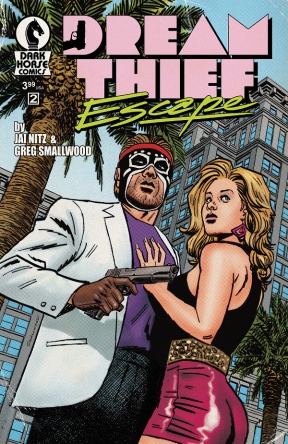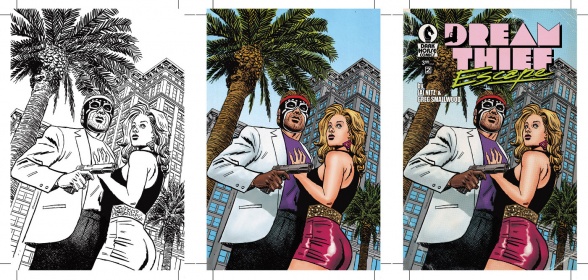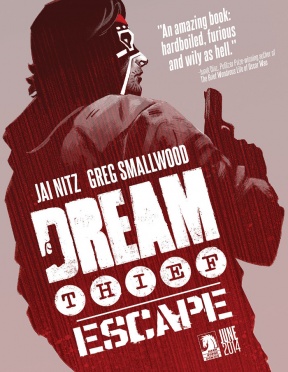“Dream Thief” from Jai Nitz and Greg Smallwood was one of the best mini-series of 2013, and with the way that it ended, we both knew more was coming and couldn’t wait for it to arrive. Thankfully, Nitz and Smallwood didn’t make us wait too long, as the second volume, subtitled “Escape”, is coming this June. We named it our most anticipated Dark Horse release in June, and from what we’ve seen, it looks completely brilliant.
With FOC here (get your order into your shop today with Diamond code APR140050!), I reached out to Nitz and Smallwood to talk about how this book originally came together, why they work so well together, what’s next for John Lincoln and the rest of their cast, and much more. Take a look, and seriously, don’t miss this book. It’s an amazing book and if you’re a fan of good comics of any variety, I heartily recommend it.
With the way the first volume of Dream Thief ended, it was pretty obvious there was more story to tell, it was just a question of when, not if, it felt like. What is it about this story and this collaboration that brings out the best in the two of you, and what can you tell us about the direction John Lincoln’s story goes after the first arc?
Greg Smallwood: Jai and I are both playing the long game with Dream Thief. We want every issue to be entertaining in it’s own right but we also want readers to feel like they’re on a longer journey with a set destination. Too many comics and shows run out of steam early on because they’re directionless. We have an endgame and route planned out to get there. We’ll take unplanned pit stops here or there but that’s just a natural part of storytelling.
Jai Nitz: After the first arc we explore what it means to have this curse in your family. A thing that used to be a noble/holy calling now goes against our societal rules. We want to talk about that but focus on a good yarn. We found out before Dream Thief #5 was completed that we’d sold well enough to keep going. That’s why we ended the first book with a “(Not) The End” epilogue page. Like Greg said, we had a plan in place that meant doing more than five issues, but if we had to stop there we’d feel like we completed something worthy. I think Dream Thief taps into areas that Greg and I both excel at. We both like crime and action but we also like character acting moments that only our medium has to offer. Besides that, we live less than a mile from each other. So we get together all the time and break down stuff we like, stuff we dislike, and our own stuff. We both love stories and our closeness in age, background, and proximity makes for a better collaboration.

JN: I think the book thrives because of our closeness. It’s not just that I can rely on Greg to draw certain aspects right– he does that because he’s a good artist– but I can rely on him to call me on my bullshit. He’s seen enough of my writing to know when I’ve gotten it wrong. And he knows how to push me to do better. He also knows when I’m trying to do a thing writing. It’s really hard to get that subtext across to your collaborator without sounding like a pretentious ass. It helps being close friends. And, yes, I trust Greg with every aspect of storytelling. I like to give collaborators the benefit of the doubt, but I don’t mind taking a backseat to Greg when he is firing on all cylinders.
Continued belowGS: The creation process is definitely smoother when there’s a certain level of comfort. We don’t create the comic in a simple two-stage process where Jai writes the script without my input and I draw it without his. It’s really organic and it goes back and forth quite a bit before it hits the printer.
From what I understand, this book had a bit of journey to go from conception to release. What made this story something the two of you couldn’t help but tell, and how do you feel your work on it has improved from conception to the first volume to the upcoming Escape?
GS: Jai’s concept was too good to give up on. He just needed a little more time to zero in on what made it work and figure out the approach. And I needed more time to figure out how to draw a comic. My art on the first Dream Thief pitch is terrible. My storytelling was there but I hadn’t yet figured out inking, coloring, and lettering. I was still making a lot of rookie mistakes. By the time we did the second pitch for Dream Thief, I’d figured things out.
JN: Greg’s selling himself short. His art was pretty good. He was learning the ropes of doing EVERYTHING himself and I could see he had the special X-factor that makes the great ones great. But, yeah, my pitch was really good but we hadn’t figured out the thing that made it special. The first pitch was closer in tone to Indiana Jones than it was to what we’re doing now. Once we took out the action and camp and turned it into a story about this unlikable guy forced into incredible circumstances we found our stride. The thing about Escape is that we hit the wall a little bit at the end of the first arc. We were struggling to make the comic live up to our impossibly high standards of what good comics should be. We had reexamine our process and have fun again. Which we did. Then the pages came quicker and the story really laid itself bare for us. We just had a conversation the other day about where we want to go with this up until the end and it was very exciting. I think we’re only getting better.
This, on the surface, isn’t the most friendly book. Lead John Lincoln is a bit of a selfish prick. Spoiler alert for those who didn’t read the first volume, but the first issue ends with Lincoln awakening in a bloodbath in a room full of dead gay porn stars. In fact, John murders many people, including his girlfriend, most of whom were killed while rather disenchanted spirits were riding shotgun. Yet, this book is tremendously likable throughout, and when you finish, it definitely leaves you wanting more. How delicate of a balance was it it for you two to have storytelling that has teeth, yet creates a world that is inviting to the reader? Were there any segments or panels where either of you thought, “mayyyybe we should dial this back”?
GS: Our editors at Dark Horse are pretty good about letting us know when we’ve crossed any lines so that alleviates a lot of apprehension. If they’ve given it a green light, we know it’s within the bounds of good taste. It’s interesting because neither one of us are interested in shocking readers. Surprising readers? Sure. But more than anything, Jai and I are just trying to capture reality. John Lincoln is a prick because there are lots of pricks out there in the real world. Everybody knows someone like John and I think that makes him endearing. He’s a real person and not a caricature. No matter how crazy the book gets, the story is always grounded by a believable lead. And I think that’s a testament to Jai’s writing.
JN: Greg draws the best “acting” this side of Kevin Maguire, so I give him a ton of credit for the success of the character. From the original pitch I wanted John Lincoln to be a jerk. He’s the kind of guy nerds hated growing up. Everything is easy for him on the surface. He’s smooth, he’s good looking, girls like him, he skates by when the rest of us are working our asses off. The problem is that those people don’t succeed well past the age of twenty-five. The gold loses its luster. I wanted to write about a guy like that getting his comeuppance to a degree. I mean, I always envied that guy, so I wanted him to pay for life being good to him. While that kind of guy was going on dates with the hottest girls in high school or college I was at home DMing my friends through a dungeon.
Continued belowGreg credits my writing while I credit my personally-created nerd torment. John’s actions are kind of the same story. Most of the time he’s thrust into a situation that he can’t control so all he deals with is the fallout. Again, it’s fun to put that jerk through the wringer than it is to imagine myself in those situations. And like Greg said, we aren’t out to shock anyone. But we’re out to surprise readers by making them think. Watching a character that you dislike-but-understand go through trials and tests makes you feel more sympathetic in the end when they succeed or fail.

One of the things that make this book tremendously unique is the way places where traditional elements are replaced with iconography or other graphic elements, like in the first issue when one of the ladies responds to Reggie’s arrival with a Facebook like icon, or in moments like when John discovers his girlfriend dead and you guys use the interrobang for the first time. I talked to you about this a bit Greg during Artist August, but how do things like that come together? What do you think using those elements instead of, say, some internal monologue or external dialogue, does to make the storytelling both more unique and effective?
JN: The Facebook “like” icon was ALL Greg (and I fell in love with it immediately). The interrobang and other symbols we used were the result of years of comic book reading experience for both of us. I made sure we pulled out every tool in the box. Why shouldn’t we use thought balloons? Everyone should! Alan Moore and Frank Miller almost killed thought balloons in 1986, but they’re a dynamic and singularly-comic book vocabulary tool. The first issue had two narrations going and everyone warned us it would be confusing… until they got the last page and the payoff was so good it warranted the dueling nature. I’d rather have the opportunity to put every trick on the table and then rein in what we do rather than be afraid to expand. Comic book readers are savvy people. There’s no reason to babystep them through the language of comics.
GS: We’ll use whatever we can to tell the story. But I think it’s important to note that neither one of us are just coming up with gimmicks and finding excuses to plug them into the comic. The gimmicks and elements you’re talking about are solutions to problems we faced in the storytelling. How can we avoid on-the-nose dialogue and best communicate to the reader that this girl likes Reggie? The Facebook “like” symbol was the solution. Nothing could communicate her reaction to Reggie better or faster. So it’s less about being unique and more about using every device available to us and taking advantage of visual shortcuts.
This is a really hard thing to do, given that it’s the second volume, but with Escape did the two of you add anything to make it easier for new readers to jump in on? Or is this very much something you’ll need to read the first volume for?
JN: I think we did that well with every issue of Dream Thief volume 1. We made each issue stand alone and provide a complete story while still building on the mythos we were creating. We tried to do the same thing with Escape while making it less of a possession-of-the-week book. That said, I hate just about every issue we do. But the issue I hated most (#4 of volume 1) turned out to be our best issue. This just proves, as always, that I’m an idiot.
GS: I wish I could say that we’re new reader friendly but we’re not. We added little moments here and there to remind our audience of stuff that happened in volume one but it’s going to go over your head if you haven’t read the first mini. Volume one was a lot like the first season of Justified where the creators used a lot of one-and-done episodes in order to familiarize the audience with Raylan Givens and his particular brand of justice. Dream Thief: Escape is more like season 2 where the writers dispensed of the episodic format and threw Raylan into a season-long story. We’ve introduced readers to John Lincoln and his world and now it’s time to take that plunge into the deep end.
Continued below
JN: Reggie and Jenny will die horrible deaths as soon as possible. Not really. Maybe. I love writing both of them and they are both long game characters. John needs different sounding boards for his new problems. They serve as the human connection to the fantastical ride he’s on. As the game changes, so does his relationship with both Reggie and Jenny. So we plan on keeping them around. Until we kill them.
One element that looms over like a specter over John’s life is the mask. How much of Escape is going to be about exploring the mythology and story behind that, and how that connects him to his father? Is that the curse that looms over the Lincoln family?
JN: Escape is all about fathers and sons, so we get into it as much as we care to reveal. I think readers get too hung up on the minutiae and encyclopedic knowledge of a story. Part of that is a good thing– people are thinking, ruminating, and discussing the entertainment you provide. But most of that is bad because people want answers for story elements that have no answer. One question I asked from day one was, “Did John steal the mask, or did the mask steal John?” I don’t know if we’ll ever answer that definitively.
Dream Thief is really a comic and a story that feels very unique and very much its own thing. But for the both of you, who and what would you say the biggest influences are on your work on Dream Thief? Were there particular inspirations that were a little out of the norm for you on this project?
JN: The main influences on me writing Dream Thief have been real life news stories and the short-lived NBC show Journeyman. Journeyman was a really dark take on Quantum Leap, and I’ve always described Dream Thief as a reverse Quantum Leap. Instead of jumping into other peoples’ lives and making them better, people jump into his life and make it worse. Most of my favorite entertainment serves as subtextual influence rather than textual. I’m unabashed in my love for Grant Morrison, but I don’t write like he does. I dig shows like The Wire, Deadwood, Rome, and Game of Thrones but Dream Thief isn’t a sprawling epic with dozens of characters. I try to draw more from the heartbreak that writers like David Simon, David Milch, John Milius, David Benioff, and Junot Diaz provide. If you can break their hearts, you win.
GS: Tonally, Jai and I are inspired by the same stuff – Michael Mann, The Wire, Journeyman, etc. Art-wise, my biggest influences would be guys like Alex Toth, Chris Samnee, and Sean Phillips. But I think those inspirations are fairly obvious with a quick glance at my work. As far as less obvious influences go, I’m a huge fan of “indie” guys like Daniel Clowes, Adrian Tomine, and Jordan Crane. They’re experts at telling personal stories and they rely heavily on their art to convey character and atmosphere. I use a lot of their tricks in Dream Thief.
Last question, and this is always a tough one: why should readers pre-order Dream Thief: Escape #1? What do you think helps set it apart from other comics around today?
JN: Dream Thief: Escape #1 is the best thing I’ve ever written with the best artist I’ve ever worked with. If you’ve ever mildly enjoyed something I’ve written in the past, you’ll love this. If you want to watch a comic art star being born in real time, check out this book because Greg Smallwood is penciling, inking, coloring, and lettering the book. Come for the murder, stay for the heartbreak.



